Press ‘Pattern’ > ‘Create Background’ to estimate automatically the background. Then select
‘Pattern’>’Subtracted Background’ to subtract the background contribution from the experimental
pattern. The background can be modified manually selecting ‘Pattern’>’Background Options’.
Background Options Dialogue

Background Type: four different types of background are available.
| Cubic Spline: | the selected background points are used for a cubic spline interpolation. |
| Polynomial: | the selected background points are fitted via Chebyshev polynomial function (default choice). |
| Bezier Spline: | the selected background points are interpolated via Bézier curve. |
| Filter: | activates a low-pass filter according to Brückner algorithm (Brückner, 2000). |
If ‘None’ option is selected the background will be not estimated.
Add points/Del points: press button ![]() to add (use left click mouse) or delete points (use right click mouse) from the graphic area for background calculation. This option is not activated in case of background filter type.
to add (use left click mouse) or delete points (use right click mouse) from the graphic area for background calculation. This option is not activated in case of background filter type.
Set number of coefficients: selects the number of coefficients for polynomial background. Press
button AUTOMATIC for automatic selection of the polynomial degree. Chi-Square estimates the agreement between the calculated and experimental background points.
If ‘Filter’ type is selected the following window is shown by the program.

No. of iterations: number of iterations of filter background.
Window size: number of points used to smooth the background.
2-theta range: sets the range in which the background filter will be applied. Use Min button MIN and Max button MAX to select the 2θ powder pattern minimum and maximum values, respectively.
Apply: press button APPLY to apply filter settings in the selected 2θ range.
Reset: press button RESET to restore the default filter settings.
Default: restores the default Background Options.